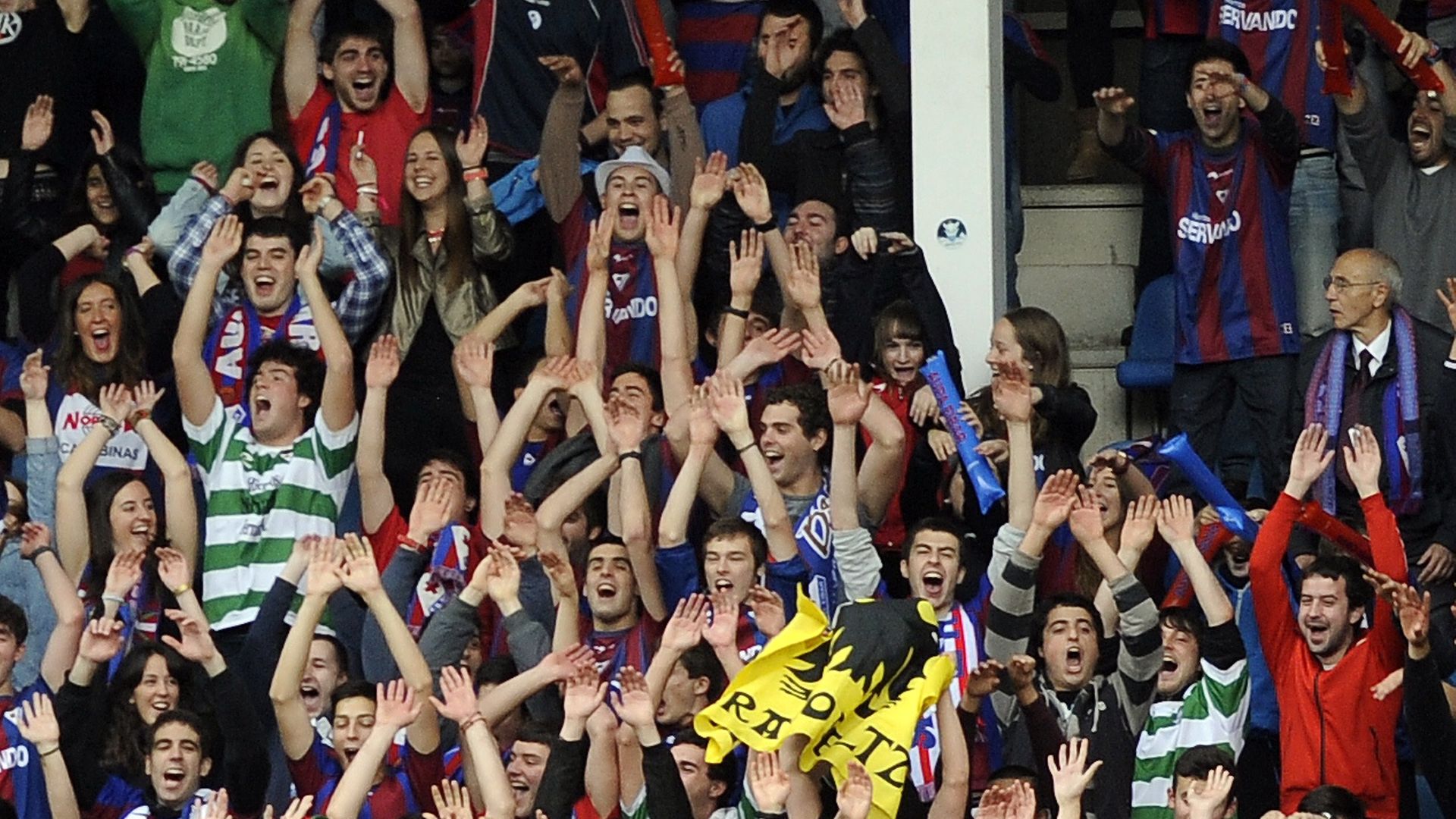
The tiny football club of Eibar has defied gravity by staying in the top flight for six years. But its luck looks like finally running out.
Never mind the ongoing travails of FC Barcelona, another, sadder, story of downfall in Spanish football is being played out, as the end of the La Liga season nears.
After six years of defying gravity by remaining in the top flight, the minnows of Eibar look like finally succumbing to relegation from the division.
If their fate is sealed it will bring to a close a remarkable chapter in European football, a tale of folkloric proportions played out in a stadium markedly smaller than non-league Stockport County’s Edgeley Park. Indeed, the population of the town of Eibar itself, in Spain’s Basque region, is only one third of the capacity of Barcelona’s Camp Nou.
Eibar’s arrival in the top flight in 2014 made them the smallest club ever to reach La Liga. The club marks its 80th anniversary this year and for most of those years it has toiled not even in the second tier, but far further down, in the regional, non-professional reaches of Spanish football.
When the moment of promotion finally came – with a 1-0 victory over Deportivo Alavés – it was celebrated with confetti generously supplied by Barcelona who no longer needed it having failed to win the anticipated Spanish league title a week earlier.
It wasn’t the first time the Basque side had benefitted from a donation from the Catalan club, which provided a set of used kits to Eibar shortly after it was founded. The Basques still play in the same claret and blue as the Blaugrana.
Before the confetti had all been cleared away, however, there were serious doubts over whether Eibar would actually be able to take their place in La Liga. Spanish regulations requiring minimum capital reserves for its top clubs meant Eibar needed money, and fast, to prevent automatic relegation, not just back to the second tier, but straight to the third.
The club – known as los Armeros (the Gunners), or Armaginak in Basque, in honour of the town’s connection to the armaments industry – had to raise 1.9m euros, four times more than its actual capitalisation at the time.
It gave supporters the chance to buy the first round of shares available, which enabled it to raise 28% of its target. Then the Defiende Al Eibar (Defend Eibar) campaign began in earnest. This second round was open to anyone around the globe to purchase shares. Once their promotion to La Liga was officially confirmed on the pitch, the sales of shares started snowballing in more than 50 countries.
In the end it wasn’t the goal from Jota (who later played for Brentford, Birmingham and Aston Villa) in the win against Alavés that officially sealed promotion, it was several weeks later when Eibar’s oldest fan, Luis María Cendoya, symbolically purchased the last share required.
The chapter underlines how keeping the tiny club – from a town of just 27,000 people – financially afloat has been as challenging as holding their own on the field against the likes of Barcelona, Real Madrid, Atletico, et al. It also shows how skewed the rules of Spanish football are. Given the financial chaos that some teams are known for it seems ironic that the rules almost sunk one of the few clubs that was financially sound.
However, the arcane rules turned out to help Eibar the following season. The club finished in 18th place in La Liga, a relegation position, but were reprieved when 13th-placed Elche were sent to the second tier as punishment for financial mismanagement.
The following season, La Liga changed the way it sold its TV rights and the distribution of the money became fairer, following a similar model to the English Premier League. Spain’s big clubs could no longer negotiate their own TV deals that left the smaller ones behind. This has helped Eibar to maintain its top tier status since that lucky season, finishing as high as 9th in 2017/18, above all its other Basque rivals.
Its relative success has made Eibar a model for other clubs. Its motto, ‘Another Football is Possible’, hints at the alternative, sustainable approach it has pioneered, with a squad made up of young players, free transfers and canny loan signings. The Modelo Eibar means it is one of the few Spanish teams to have no debt whatsoever.
It has innovated in other ways too. Until 2019 the top two non-sporting management positions were held by women: Amaia Gorostiza, who has been president since 2016, and Patricia Rodriguez, who was the only female chief executive in Spain’s top flight, until her departure.
Despite its tiny size and financial limitations, the club has enjoyed some impressive results during its La Liga tenure. In 2018 it beat Real Madrid 3-0. In their final game of 2020 they held Barca to a draw at the Nou Camp.
Alas, it now looks like this remarkable tale of survival against the odds may be coming to an end, as the club finds itself mired in a relegation battle as the season draws to a close. There are still games left to play their way to safety, but it will be tough.
Seven of their last 10 games are against sides in the top 10, including Atletico and Real Madrid. Their problem is one familiar to most struggling teams – a lack of goals. After 28 games they had scored only 22 goals and had missed several crucial penalties.
Their final game of the season is at home to Barcelona. Will their occasional benefactors be able to do them one more favour?
SCOTTISH LINK
As with a remarkable number of Spanish clubs, Eibar have deep links with Scotland, and these ones are more intense than most. The town’s coat of arms contains a St Andrew’s cross but the true bond seems to have been formed more recently, and via a different sport. Eibar’s followers gravitated towards Scotland in the 1990s due to rousing rugby displays – by players and supporters – in the old Five Nations.
Up until then, La Bombonera had been Eibar’s main ultra group, but a growing fascination with all things Caledonian saw them replaced by Eskozia La Brava (‘Scotland the Brave’). Match days (pre-Covid) saw a sea of Saltires, ‘See You Jimmy’ hats, tartan and bagpipes.
Before lockdown, one of Eibar’s best known fans was Blas Sánchez, known as ‘El Pintor’ (The Painter), who watched matches from behind the east goal with his trademark cigar and claret and blue umbrella – complete with burnt cigar holes. He was also a fixture of Spanish football show El Día Después, which regularly featured his jokes, rants and chants. Sadly, Blas was one of Spain’s victims of Covid last year. At a subsequent match, players and officials paid tribute to him, with his umbrella and hat laid out on the side of the pitch.
What do you think? Have your say on this and more by emailing letters@theneweuropean.co.uk









